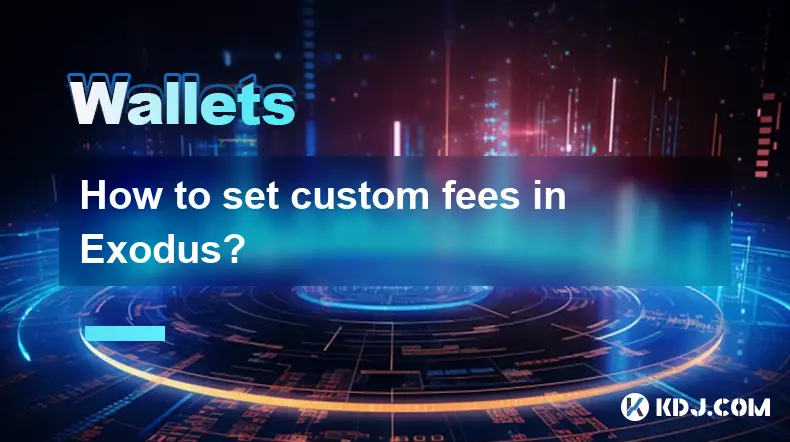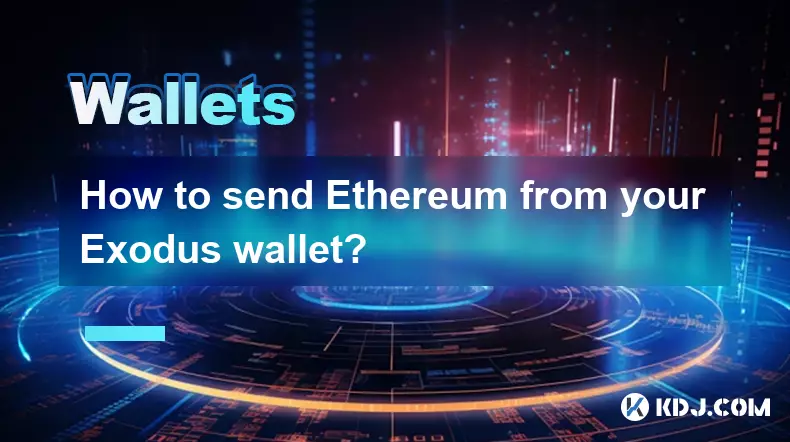-
 bitcoin
bitcoin $115469.758015 USD
0.29% -
 ethereum
ethereum $4536.640472 USD
-1.35% -
 xrp
xrp $2.998395 USD
-1.04% -
 tether
tether $1.000274 USD
-0.02% -
 bnb
bnb $921.981367 USD
-0.33% -
 solana
solana $235.464989 USD
-2.21% -
 usd-coin
usd-coin $0.999955 USD
0.02% -
 dogecoin
dogecoin $0.269732 USD
-2.68% -
 tron
tron $0.345815 USD
-0.84% -
 cardano
cardano $0.865586 USD
-2.26% -
 hyperliquid
hyperliquid $53.710810 USD
0.30% -
 chainlink
chainlink $23.619558 USD
-1.81% -
 ethena-usde
ethena-usde $1.001114 USD
-0.01% -
 sui
sui $3.539388 USD
-3.58% -
 avalanche
avalanche $29.724102 USD
1.08%
How to set custom fees in Exodus?
Exodus Wallet lets users customize transaction fees for faster or cheaper crypto transfers, with manual controls for Bitcoin, Ethereum, and more during network congestion.
Sep 12, 2025 at 05:01 am

Understanding Custom Fees in Exodus Wallet
Exodus is a non-custodial cryptocurrency wallet that supports a wide range of digital assets. One of its key features is the ability to customize transaction fees, giving users control over how much they pay when sending crypto. By setting custom fees, users can influence the speed at which their transactions are confirmed on the blockchain. Higher fees generally result in faster confirmations, while lower fees may lead to delays, especially during network congestion.
Custom fee settings are particularly useful during periods of high network activity. For example, when the Bitcoin or Ethereum network experiences a surge in transactions, default fees may not be competitive enough to get timely confirmations. Adjusting fees manually allows users to respond dynamically to network conditions.
Steps to Set Custom Fees in Exodus
- Open the Exodus wallet application on your desktop or mobile device and unlock your wallet using your password or biometric authentication.
- Navigate to the asset you wish to send by selecting it from the main dashboard. Click on the 'Send' button located within the asset interface.
- Enter the recipient's wallet address and the amount of cryptocurrency you want to transfer.
- Before confirming the transaction, locate the fee settings option, usually labeled as 'Advanced Options' or represented by a slider icon.
- Click on the fee settings to reveal the custom fee adjustment panel. Here, you can manually set the fee rate based on satoshis per byte (for Bitcoin) or gwei (for Ethereum and ERC-20 tokens).
Factors Influencing Fee Selection
- Network congestion plays a major role in determining appropriate fee levels. When many users are sending transactions, miners or validators prioritize those with higher fees.
- The size of the transaction in bytes affects the total fee. Transactions with multiple inputs or complex scripts require more data and thus incur higher costs at the same fee rate.
- Wallets like Exodus often display estimated confirmation times next to fee levels. These estimates are based on real-time blockchain data and can help users decide between economy, standard, and priority fees.
- Some assets, such as Bitcoin, allow precise fee control, while others may have limited customization due to protocol constraints.
- Users should always verify current network conditions using external blockchain explorers before setting unusually low or high fees.
Risks and Best Practices
- Setting a fee too low may result in the transaction remaining unconfirmed for hours or even days. In extreme cases, the network may drop the transaction entirely.
- Overpaying fees unnecessarily reduces the net amount received by the recipient and increases costs for the sender.
- It is advisable to test custom fees with small amounts first, especially when using Exodus for the first time with a particular asset.
- Always double-check the total fee displayed before confirming the transaction. Exodus shows both the fee rate and the total fee in the selected cryptocurrency and its fiat equivalent.
- If a transaction is stuck due to a low fee, some blockchains support Replace-by-Fee (RBF), allowing users to increase the fee and re-broadcast the transaction. However, this feature must be enabled at the time of sending and is not supported on all networks.
Frequently Asked Questions
Can I change the fee after sending a transaction in Exodus?No, once a transaction is broadcast to the network, the fee cannot be altered unless the transaction supports Replace-by-Fee (RBF) and was sent with RBF enabled. In such cases, you may be able to create a new transaction with a higher fee to replace the original one.
Why does my Ethereum transaction fee appear so high?Ethereum fees depend on gas price (gwei) and gas limit. During periods of high demand, gas prices can spike significantly. Exodus pulls real-time gas data to suggest appropriate fees, but users can manually lower the gas price if they are willing to wait longer for confirmation.
Does setting a custom fee work for all cryptocurrencies in Exodus?Most major cryptocurrencies supported by Exodus, including Bitcoin, Ethereum, Litecoin, and Bitcoin Cash, allow custom fee settings. However, some newer or less common assets may not offer full fee customization due to technical limitations or lack of user-controlled fee mechanisms in their protocols.
How do I know if my custom fee is too low?After sending, you can check the transaction status using a blockchain explorer. If the transaction remains unconfirmed for an extended period—especially during peak network usage—it may have been submitted with an insufficient fee. Monitoring mempool activity can help assess whether your fee is competitive.
Disclaimer:info@kdj.com
The information provided is not trading advice. kdj.com does not assume any responsibility for any investments made based on the information provided in this article. Cryptocurrencies are highly volatile and it is highly recommended that you invest with caution after thorough research!
If you believe that the content used on this website infringes your copyright, please contact us immediately (info@kdj.com) and we will delete it promptly.
- MoonBull, Meme Coins, and Turbo: What's the Hype?
- 2025-09-16 10:25:13
- Ripple's RLUSD: A $25 Million Boost for Veterans and Small Businesses
- 2025-09-16 10:25:13
- Major Token Unlocks Incoming: ZRO and More!
- 2025-09-16 10:30:01
- Bitcoin Price Prediction: Will Remittix Trending Affect BTC's Next Move?
- 2025-09-16 09:10:01
- BONK Price, Fed Meeting, and Elliott Wave: What's Next?
- 2025-09-16 09:10:01
- Base Blockchain, Network Token, and Coinbase Expansion: What's the Buzz?
- 2025-09-16 08:25:12
Related knowledge

How to check your crypto portfolio performance in Exodus?
Sep 14,2025 at 08:36am
Accessing Your Portfolio Overview in Exodus1. Launch the Exodus application on your desktop or mobile device and enter your password to unlock your wa...

How to sell crypto from your Exodus wallet?
Sep 13,2025 at 12:01pm
Selling Crypto from Your Exodus WalletExodus is a popular non-custodial wallet that supports a wide range of cryptocurrencies. While it doesn’t allow ...

Can I use a Ledger Nano X with the Exodus wallet?
Sep 16,2025 at 04:36am
No, you cannot use a Ledger Nano X directly with the Exodus wallet. While both are popular tools in the cryptocurrency space, they are not compatible ...

How to back up your Exodus wallet?
Sep 11,2025 at 04:19pm
Understanding Exodus Wallet Backup Basics1. Exodus is a software wallet that allows users to store, manage, and exchange various cryptocurrencies dire...

How to send Ethereum from your Exodus wallet?
Sep 16,2025 at 11:36am
Preparing Your Exodus Wallet for Ethereum Transfer1. Ensure your Exodus wallet is updated to the latest version available on the official website or a...

How to transfer funds from Binance to your Exodus wallet?
Sep 10,2025 at 10:19pm
Connecting Your Binance Account to Exodus Wallet1. Log in to your Binance account and navigate to the 'Wallet' section under the 'Funds' tab. Select '...

How to check your crypto portfolio performance in Exodus?
Sep 14,2025 at 08:36am
Accessing Your Portfolio Overview in Exodus1. Launch the Exodus application on your desktop or mobile device and enter your password to unlock your wa...

How to sell crypto from your Exodus wallet?
Sep 13,2025 at 12:01pm
Selling Crypto from Your Exodus WalletExodus is a popular non-custodial wallet that supports a wide range of cryptocurrencies. While it doesn’t allow ...

Can I use a Ledger Nano X with the Exodus wallet?
Sep 16,2025 at 04:36am
No, you cannot use a Ledger Nano X directly with the Exodus wallet. While both are popular tools in the cryptocurrency space, they are not compatible ...

How to back up your Exodus wallet?
Sep 11,2025 at 04:19pm
Understanding Exodus Wallet Backup Basics1. Exodus is a software wallet that allows users to store, manage, and exchange various cryptocurrencies dire...

How to send Ethereum from your Exodus wallet?
Sep 16,2025 at 11:36am
Preparing Your Exodus Wallet for Ethereum Transfer1. Ensure your Exodus wallet is updated to the latest version available on the official website or a...

How to transfer funds from Binance to your Exodus wallet?
Sep 10,2025 at 10:19pm
Connecting Your Binance Account to Exodus Wallet1. Log in to your Binance account and navigate to the 'Wallet' section under the 'Funds' tab. Select '...
See all articles










































































